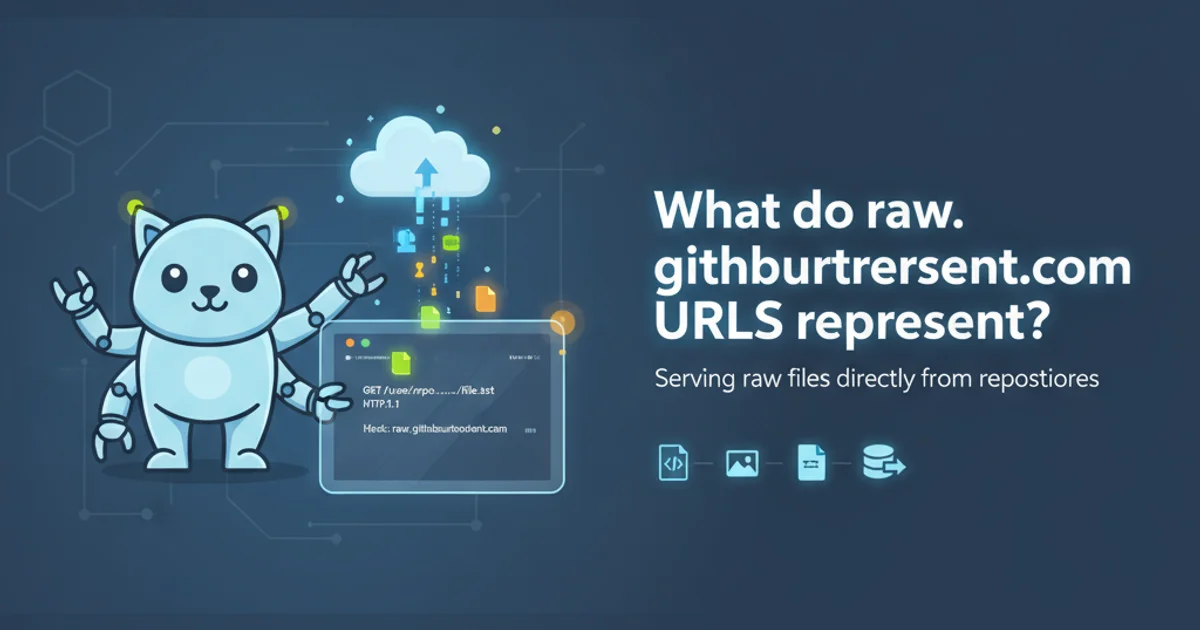What do raw.githubusercontent.com URLs represent?
Categories:
Understanding raw.githubusercontent.com URLs: A Deep Dive

Explore the purpose, security implications, and common uses of raw.githubusercontent.com URLs, from serving raw files to package management.
If you've spent any time working with GitHub, especially when dealing with configuration files, scripts, or package managers like Homebrew, you've likely encountered URLs starting with raw.githubusercontent.com. These URLs are distinct from the typical github.com URLs and serve a very specific purpose: delivering the raw, unrendered content of files directly from a GitHub repository. This article will demystify these URLs, explain their function, discuss their security considerations, and illustrate common use cases.
What is raw.githubusercontent.com?
GitHub is primarily a platform for version control and collaborative software development. When you browse a file on github.com, you see it rendered with syntax highlighting, line numbers, and other UI elements. However, many tools and scripts need direct access to the file's content without any of GitHub's web interface dressing. This is where raw.githubusercontent.com comes in.
It's a content delivery network (CDN) subdomain managed by GitHub, specifically designed to serve the raw content of files stored in GitHub repositories. When you access a file through this domain, you get exactly what's in the file, byte for byte, without any HTML wrappers or JavaScript. This makes it ideal for programmatic access, embedding content, or distributing scripts.
flowchart TD
A[User/Tool Request] --> B{github.com/user/repo/blob/branch/file.ext}
B --"Rendered HTML"--> C[Web Browser (UI)]
A --> D{raw.githubusercontent.com/user/repo/branch/file.ext}
D --"Raw File Content"--> E[Script/Program/Browser (Direct Content)]
C --"User Interaction"--> F[Code Editing/Browsing]
E --"Execution/Consumption"--> G[System Operation/Data Use]
style B fill:#f9f,stroke:#333,stroke-width:2px
style D fill:#bbf,stroke:#333,stroke-width:2pxComparison of github.com vs. raw.githubusercontent.com content delivery
Structure of a raw.githubusercontent.com URL
The structure of a raw.githubusercontent.com URL is straightforward and directly mirrors the path within the GitHub repository, with a slight modification for the domain and the branch name.
General format:
https://raw.githubusercontent.com/{username}/{repository}/{branch}/{path/to/file}
Let's break down an example:
https://raw.githubusercontent.com/Homebrew/install/HEAD/install.sh
raw.githubusercontent.com: The base domain for raw content.Homebrew: The GitHub username or organization.install: The repository name.HEAD: The branch name.HEADoften refers to the default branch (usuallymainormaster).install.sh: The path to the file within the repository.
curl -fsSL https://raw.githubusercontent.com/Homebrew/install/HEAD/install.sh
Example of using curl to fetch a raw script from GitHub
Common Use Cases
These URLs are indispensable for various development and automation tasks:
- Script Distribution: Many open-source projects, like Homebrew, provide installation scripts directly via
raw.githubusercontent.com. Users cancurlorwgetthese scripts and pipe them directly into an interpreter. - Configuration Files: Tools often need to fetch configuration files (e.g.,
.yaml,.json,.ini) from a central repository. Using the raw URL ensures they get the pure data. - Embedding Content: Developers might embed raw code snippets, markdown files, or even small images directly into web pages or applications.
- Package Managers: Beyond Homebrew, other package managers or build tools might use these URLs to fetch dependencies or build instructions.
- CI/CD Pipelines: Automated build and deployment pipelines frequently use raw URLs to pull down scripts, test data, or deployment manifests.
curl ... | bash) carries significant security risks. Always review the script's content before executing it, especially if it comes from an untrusted source. Malicious actors can compromise repositories or branches to serve harmful code.Security Considerations
The convenience of raw.githubusercontent.com comes with security implications that users and developers must be aware of:
- Trust: The primary concern is trusting the source. If the repository or the specific branch is compromised, the raw content could be altered to include malicious code.
- Immutability (or lack thereof): Unlike releases or tags, branches (like
mainorHEAD) are mutable. The content of a file at a given raw URL can change over time as new commits are pushed. For critical applications, it's safer to reference specific commit SHAs rather than branch names to ensure immutability. - CORS (Cross-Origin Resource Sharing): Browsers enforce CORS policies, which can restrict how content from
raw.githubusercontent.comis used in web applications. While it's great for direct downloads, embedding resources like fonts or scripts might require specific CORS headers, which GitHub provides for raw content. - Rate Limiting: Like other GitHub services,
raw.githubusercontent.comis subject to rate limiting. Excessive requests from a single IP address might lead to temporary blocking.
# Fetching a specific commit for immutability
curl -fsSL https://raw.githubusercontent.com/Homebrew/install/a1b2c3d4e5f6g7h8i9j0k1l2m3n4o5p6q7r8s9t0/install.sh
Referencing a specific commit SHA for stable content
raw.githubusercontent.com to mitigate risks associated with external dependencies and potential rate limits.